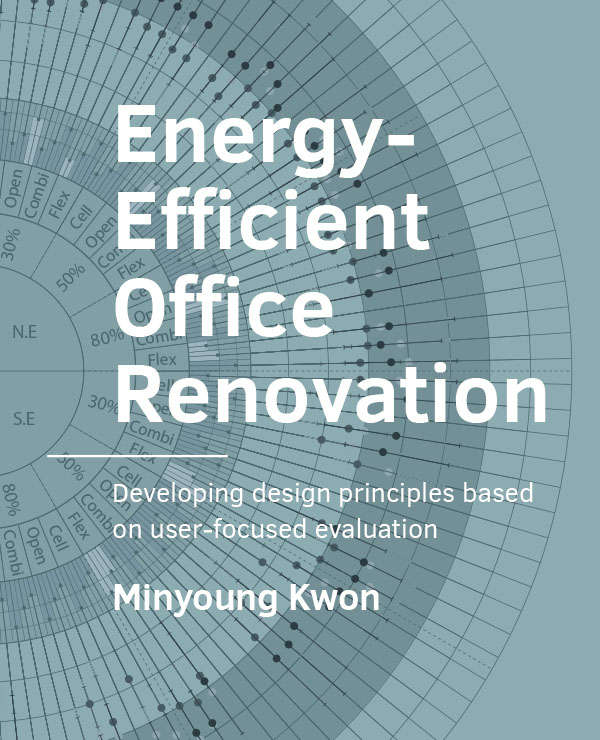The Impact of Design Parameters on Energy Demand for Office Renovation
DOI:
https://doi.org/10.7480/abe.2020.15.4453Abstract
Chapter 6 showed that the office layout and desk location were the most influential design factors for the thermal and visual comfort of users, and layout and orientation were most influential for psychological comfort in office buildings. Office design parameters were analysed to optimise user satisfaction in relation to indoor environmental and organisational quality in office buildings by showing predictable models. However, the predicted satisfaction models had not been tested in terms of energy performance. Therefore, this chapter evaluates the energy performance of the predicted models by computational assessment.a
Section 7.2 explains the energy simulation scheme, model typologies, and simulation parameters. Section 7.3 presents the comparison of energy simulation results based on three design factors such as office layout, orientation and WWR. The results present the differences of the energy demand according to the alternative office typologies and contribution of design factors. The annual energy demand of 24 models are compared on the basis of different model typologies, and present the most energy-efficient typologies in section 7.4.
References
Ahmed, K., Carlier, M., Feldmann, C., & Kurnitski, J. (2018). A New Method for Contrasting Energy Performance and Near-Zero Energy Building Requirements in Different Climates and Countries. Energies, 11(6), 1334.
Allouhi, A., El Fouih, Y., Kousksou, T., Jamil, A., Zeraouli, Y., & Mourad, Y. (2015). Energy consumption and efficiency in buildings: current status and future trends. Journal of Cleaner production, 109, 118-130.
Bouwbesluit2012. (2011). Bouwbesluit 2012. In: Staatsblad.
Cabeza, L. F., Rincón, L., Vilariño, V., Pérez, G., & Castell, A. (2014). Life cycle assessment (LCA) and life cycle energy analysis (LCEA) of buildings and the building sector: A review. Renewable and Sustainable Energy Reviews, 29, 394-416.
CEN, E. (2007). 15251, Indoor environmental input parameters for design and assessment of energy performance of buildings addressing indoor air quality, thermal environment, lighting and acoustics. European Committee for Standardization, Brussels, Belgium.
Chen, X., Yang, H., & Zhang, W. (2018). Simulation-based approach to optimize passively designed buildings: A case study on a typical architectural form in hot and humid climates. Renewable and Sustainable Energy Reviews, 82, 1712-1725. doi:https://doi.org/10.1016/j.rser.2017.06.018
Danielsson, C. B., & Bodin, L. (2008). Office type in relation to health, well-being, and job satisfaction among employees. Environment and behavior, 40(5), 636-668.
Goia, F. (2016). Search for the optimal window-to-wall ratio in office buildings in different European climates and the implications on total energy saving potential. Solar Energy, 132, 467-492. doi:http://dx.doi.org/10.1016/j.solener.2016.03.031
Haynes, B., Suckley, L., & Nunnington, N. (2017). Workplace productivity and office type: An evaluation of office occupier differences based on age and gender. Journal of Corporate Real Estate, 19(2), 111-138.
Haynes, B. P. (2008). The impact of office layout on productivity. Journal of Facilities Management, 6(3), 189-201.
Heo, Y., Choudhary, R., & Augenbroe, G. (2012). Calibration of building energy models for retrofit analysis under uncertainty. Energy and Buildings, 47, 550-560.
Jung, N., Paiho, S., Shemeikka, J., Lahdelma, R., & Airaksinen, M. (2018). Energy performance analysis of an office building in three climate zones. Energy and Buildings, 158, 1023-1035. doi:https://doi.org/10.1016/j.enbuild.2017.10.030
Kang, H., Lee, M., Hong, T., & Choi, J.-K. (2018). Determining the optimal occupancy density for reducing the energy consumption of public office buildings: A statistical approach. Building and Environment, 127, 173-186.
Koornneef, F. (2012). Converting office space: Using modular prefab architecture to convert vacant office buildings.
Li, D. H. W., & Lam, J. C. (2001). Evaluation of lighting performance in office buildings with daylighting controls. Energy and Buildings, 33(8), 793-803. doi:https://doi.org/10.1016/S0378-7788(01)00067-6
Lin, Y.-H., Tsai, K.-T., Lin, M.-D., & Yang, M.-D. (2016). Design optimization of office building envelope configurations for energy conservation. Applied energy, 171, 336-346.
Musau, F., & Steemers, K. (2008). Space planning and energy efficiency in office buildings: the role of spatial and temporal diversity. Architectural Science Review, 51(2), 133-145.
Ochoa, C. E., Aries, M. B., van Loenen, E. J., & Hensen, J. L. (2012). Considerations on design optimization criteria for windows providing low energy consumption and high visual comfort. Applied energy, 95, 238-245.
Pandharipande, A., & Caicedo, D. (2011). Daylight integrated illumination control of LED systems based on enhanced presence sensing. Energy and Buildings, 43(4), 944-950. doi:https://doi.org/10.1016/j.enbuild.2010.12.018
Paoletti, G., Pascual Pascuas, R., Pernetti, R., & Lollini, R. (2017). Nearly zero energy buildings: An overview of the main construction features across Europe. Buildings, 7(2), 43.
Park, C.-S. (2003). Occupant responsive optimal control of smart façade systems. Georgia Institute of Technology,
Poirazis, H., Blomsterberg, Å., & Wall, M. (2008). Energy simulations for glazed office buildings in Sweden. Energy and Buildings, 40(7), 1161-1170.
Raji, B., Tenpierik, M. J., & van den Dobbelsteen, A. (2016). An assessment of energy-saving solutions for the envelope design of high-rise buildings in temperate climates: A case study in the Netherlands. Energy and Buildings, 124, 210-221.
Remøy, H. T. (2010). Out of Office: A Study on the Cause of Office Vacancy and Transformation as a Means to Cope and Prevent: IOS Press.
Rolfö, L., Eklund, J., & Jahncke, H. (2018). Perceptions of performance and satisfaction after relocation to an activity-based office. Ergonomics, 61(5), 644-657. doi:10.1080/00140139.2017.1398844
Suk, J. Y., Schiler, M., & Kensek, K. (2017). Investigation of existing discomfort glare indices using human subject study data. Building and Environment, 113, 121-130. doi:https://doi.org/10.1016/j.buildenv.2016.09.018
Tian, M., & Su, Y. (2014). An improvement to calculation of lighting energy requirement in the European Standard EN 15193: 2007. Journal of Daylighting, 1(1), 16-28.
Vos, P., van Meel, J., Dijcks, A., Estate, T. U. D. D. o. R., Management, P., Delft University of Technology, D. o. R. E., & Management, P. (2000). The Office, the Whole Office and Nothing But the Office: A Framework of Workplace Concepts, Version 1.2: Department of Real Estate & Project Management, Delft University of Technology.

